Selling on Pinterest: Top Tips For Turning Pins Into Purchases
In this blog post, we’re exploring the benefits for ecommerce retailers of selling on Pinterest, top tips for driving sales on the platform, and the functionality provided by the Pinterest for Shopify app!
Written By
Hannah Smiddy
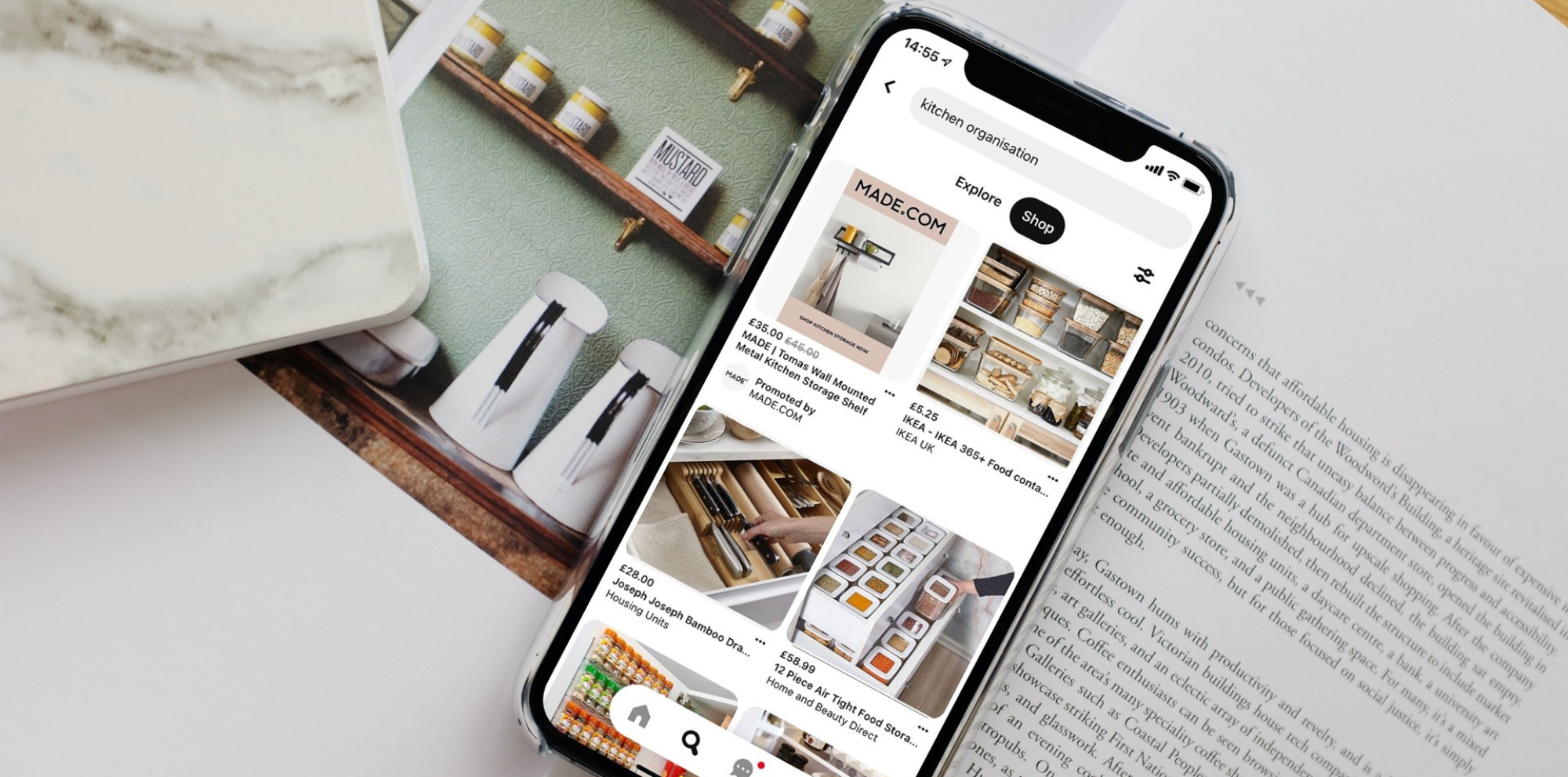
Visual discovery engine Pinterest is a place of pure inspiration; a go-to destination when it comes to finding new products and pursuing new ideas. Users, or ‘Pinners’ as they’ve come to be known, are ready-to-buy – which makes selling on Pinterest an avenue you simply can’t afford to ignore.
As an ecommerce merchant, you can leverage Pinterest to raise brand awareness, boost your brand authority, increase traffic to your website and drive conversions at pace. And for retailers using Shopify, selling on Pinterest is now easier than ever thanks to an integration that allows merchants to turn products into Pins in just a few clicks.
In this article, we’ll explore the advantages of using Pinterest as an ecommerce retailer, before sharing some top tips for driving clicks and conversions on the platform. We’ll then take a look at the Pinterest for Shopify app and the functionality it offers merchants.
Pinterest for ecommerce – what are the benefits?
Brand exposure on a big scale
With more than 478 million Pinners on board, and 5 billion searches being made every month, Pinterest represents a valuable opportunity to get your brand seen and heard by a big audience1. There are significant wins to be had as a brand on Pinterest when it comes to reaching new people and boosting your online presence.
Pinners are primed to buy
It’s not only the volume of users that should excite you when you think about Pinterest as a potential ecommerce marketing tool, it’s their mindset.
The platform is a hotspot for shoppers looking to make a purchase – in fact, 90% of weekly Pinners make purchase decisions on Pinterest 2, whilst product searches are growing more than 20x YoY3! It’s a treasure trove of inspiration, where users are primed to browse, discover and buy. Unlike other social platforms where users tend to reactively scroll through a feed, Pinners are proactively searching for things. As such, traffic coming from Pinterest is high-intent, with a strong likelihood of conversion.
What’s more, users are open to all types of brands, with 97% of top searches on the platform being unbranded4. The fact that people on Pinterest are usually open-minded and undecided spells great news for smaller businesses who’ve traditionally had to compete with big household names for visibility.
The king of average order value
Did you know that the average amount spent per order is higher on Pinterest than any other social media platform with a marketplace? Pinners generate the highest average order value, at $1545!
Simplified shopping experience
Pinterest offers users a refreshingly simplified shopping experience, with a focus on clickable content in the form of shoppable Pins. Prospective customers can click on a product they like the look of and go directly to the relevant product page on your ecommerce store – simple.
How to sell on Pinterest
So, we’ve explored what makes Pinterest so special when it comes to social commerce, but where should you begin if you’re new to marketing on the platform?
Once you’re all set up with your business Pinterest account, here are seven top tips to help you leverage the platform in your ecommerce marketing strategy.
#1 It’s all about the visuals
First thing’s first, trying to sell on Pinterest will be fruitless without some compelling, clickable visuals. These are a few must-haves:
- Professional-quality, high-res photography that will stand out in people’s feeds
- Optimised image sizes and ratios (Pinterest recommends vertical images of 1000 x 1500px, with an aspect ratio of 2:3) – visit the official spec guide for more!
- High-quality, branded graphics
- Consistent use of colours, fonts and image styles (that all match your branding!)
- Ensure any text overlays are bold, clear and concise
- Subtle placement of your logo on every Pin (avoid the lower-right corner though, as Pinterest’s product icons take this spot)
Check out these aesthetically-pleasing Pins from furniture and homeware retailer MADE.com:
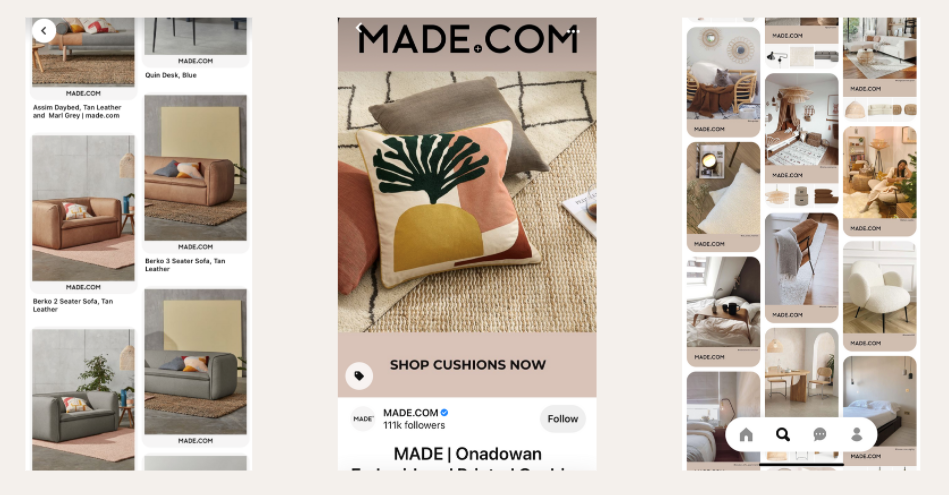
#2 Pin more than just your products
Varying the type of content you share on Pinterest is a great way to grab users’ attention, stand out from the competition and communicate your unique brand story. Mix it up and go beyond simply pinning product images.
Leverage lifestyle photographs to inspire Pinners, showcase your products in action with short video clips, and share blog posts that give users more insight into how a product can benefit them. Easily-digestible infographics are another pin-worthy type of content that users love to share.
This combination of content formats will help immerse users into your brand, encouraging them to engage and explore further.
When it comes to deciding on themes for your content, you’ll need to get clued up on your target audience and the types of topics they’re searching for online. The goal is to pin engaging, highly relevant, highly shareable content that will attract your ideal customer and position your brand as a thought leader in their eyes. Don’t limit yourself to content about your products – instead, consider any topics related to your industry that you know your customers will find interesting and useful.
Don’t be afraid to share relevant and inspiring content from other users either. We’re talking user-generated Pins that support your brand, show the benefits of your products, and provide value around related topics, rather than those of your competitors. Not only is this a good tactic for boosting confidence in your offering, but Pinners will appreciate you sharing content that’s important to them.
#3 Divide your Pins into boards
Think of your brand’s Pinterest page a bit like a physical store, where your products are grouped by collection. This gives users a helping hand navigating your offering and allows them to follow specific boards that are most relevant to their needs and interests.
Occasionwear brand Needle & Thread have done exactly this:
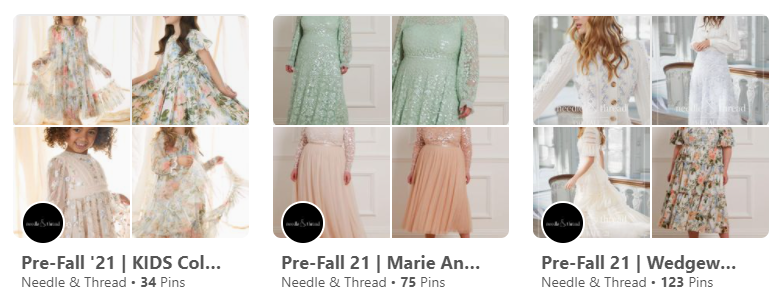
#4 Optimise your Pin descriptions for keywords
Your Pinterest for ecommerce strategy wouldn’t be complete without keyword optimisation. Do your research to uncover popular search terms, then incorporate these keywords strategically in the titles and descriptions of both your Pins and boards. You want to make it as easy as possible for people to find what they’re looking for with your Pins.
Remember what we said about the majority of Pinterest searches being unbranded? Pinners aren’t looking for something specific, so targeting some general, less direct keywords will be helpful as well.
A word of caution though – try not to stuff your descriptions with keywords, as this won’t land well with your users. You want your Pin descriptions to read naturally, encouraging users to engage with your brand.
You can also optimise your Pin descriptions with relevant hashtags. The closer your Pins match users’ search intent, the higher up they’ll appear in their feeds.
#5 Be consistent
Pinning consistently is important in order to be seen as an ‘active creator’ by Pinterest. What does ‘consistently’ mean though?
Well, it’s recommended that you post daily for maximum effect. Try to avoid simply pinning for the sake of pinning though – make sure you only pin quality content that you know will engage and inspire your audience.
At the other end of the scale, don’t let your Pinterest account become inactive – consider using a marketing automation tool to ensure your pinning remains consistent, even when you’re out of office.
#6 Promote your Pins
Whether your goal is to grow your reach, get more traffic to your ecommerce site, drive online sales, or even increase offline sales, you can leverage Pinterest Ads to reach your desired outcome.
There are a variety of visual-first formats to choose from when it comes to ads, including static images, video, carousels and collections. Play around with different options to explore which format delivers you the best return on investment.
You can use the platform’s precise targeting tools to get your ads in front of the right people at the right time. Narrow in on your perfect audience, targeting by interest, age, gender, location and more. There’s also the option to upload your customer lists to reach people who’ve already engaged with your website.
When it comes to ad spend, you can set your own budget, or use the platform’s automatic bidding tools instead.
For a real-life success story, check out that of Dutch fashion brand Scotch & Soda. They leveraged Pinterest’s shopping ad functionality, creating simple, yet striking, visuals that would stand out to fashion-conscious consumers.
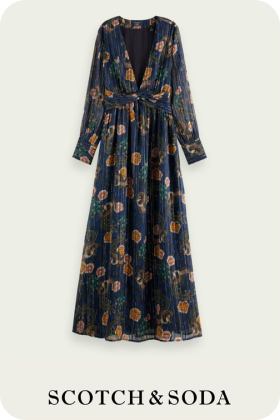
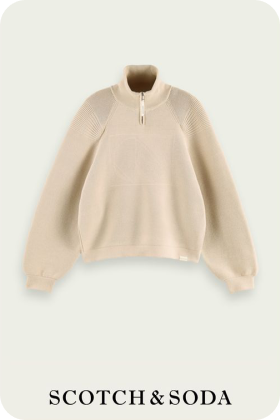
They reached their ideal Pinners with a mix of interest targeting and actalike audiences. Scotch & Soda’s performance campaign proved to be an effective full-funnel solution, generating a 7x higher return on ad spend than previous campaigns on other platforms. The ads reached 800,000 unique users and generated 550 add-to-carts!
#7 Leverage analytics data
It goes without saying that you’ll want to closely monitor the performance of your Pins – this will help you to fine-tune your strategy for optimised results. Look for Pins that users interact with the most and consider putting some ad spend behind them for an extra push. Keep an eye on those not performing particularly well too – you can tweak and test these to improve performance.
Regularly reviewing the analytics behind your account and taking advantage of Pinterest’s marketing tools will help you identify industry trends and make more informed marketing decisions as well.
For example, after identifying a surge in user searches for comfy clothes in 2020, global fashion label MANGO selected Pinterest as the perfect platform on which to launch their new everyday clothing collection.
They segmented their audience based on interests and keywords by country, ultimately reaching 1.5 million users interested in comfortable clothing (in just 15 days!). This success story demonstrates how retailers can leverage Pinterest’s search data to respond to the needs of consumers in real-time.
Pinterest Shopify app
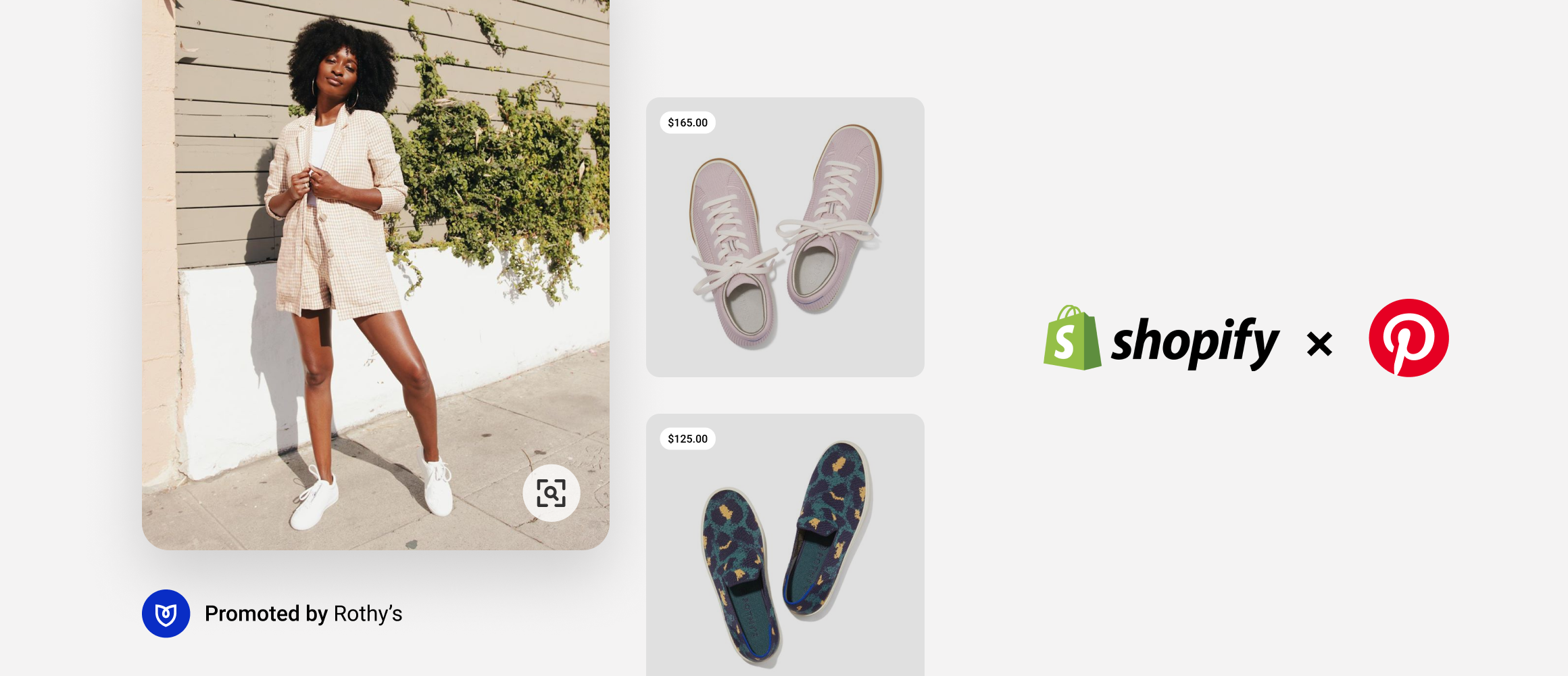
Image source: Pinterest Newsroom
Earlier this year, Pinterest’s integration with Shopify expanded from the US and Canada, reaching another 27 countries across the globe, including the UK, Australia, France and Germany. As a result, more than 1.7 million merchants can easily start selling on Pinterest and turn their products into shoppable Product Pins with Shopify’s free Pinterest app.
Here are a couple of features to look out for in particular:
Multi-feed support for product catalogs
Retailers can easily upload their products in multiple product feeds, each indicating specific local data such as currency, language or product availability. This allows merchants to add a specific feed for each market they serve, meaning they can engage more easily with customers across the globe. Product catalogs are automatically updated every day, reflecting changes in inventory.
Dynamic retargeting ads
Shopify merchants advertising on Pinterest can now re-engage with users who have previously expressed interest in their products, retargeting them with exact or similar products. It’s important to note though, to use this feature, you’ll need to meet a threshold for a minimum number of ‘Page Visit’ and ‘Add to Cart’ events in the last seven days.
Summary
With a well-executed strategy, and a little bit of patience, there are big rewards to be had as a retailer on Pinterest. Selling your products on Pinterest could generate an entirely new revenue stream. By consistently pinning beautiful, inspiring visuals, and keeping up-to-date with what your audience is searching for, you’ll be well on your way to leveraging Pinterest’s ready-to-buy audience and turning Pins into purchases!
Your integrated ecommerce agency
Here at Swanky, we’ll not only design and build your ecommerce store, we’ll help elevate your brand to new heights with our commercially-guided, experience-led growth strategies. Our multidisciplinary specialists provide full in-house delivery of all sorts of services, including conversion rate optimisation, personalisation, email marketing and social media management (including Pinterest!).
Talk to our team today to see how we could unlock your ecommerce potential.
For reference:
[1] https://www.socialmediatoday.com/news/pinterest-now-facilitates-more-than-5-billion-searches-per-month/600578/
[2] https://www.omnicoreagency.com/pinterest-statistics/
[3] https://www.socialmediatoday.com/news/pinterest-now-facilitates-more-than-5-billion-searches-per-month/600578/
[4] https://newsroom.pinterest.com/en/post/pinterest-and-shopify-expand-partnership-to-boost-social-commerce-globally
[5] https://www.practicalecommerce.com/charts-social-medias-impact-on-ecommerce-revenue

